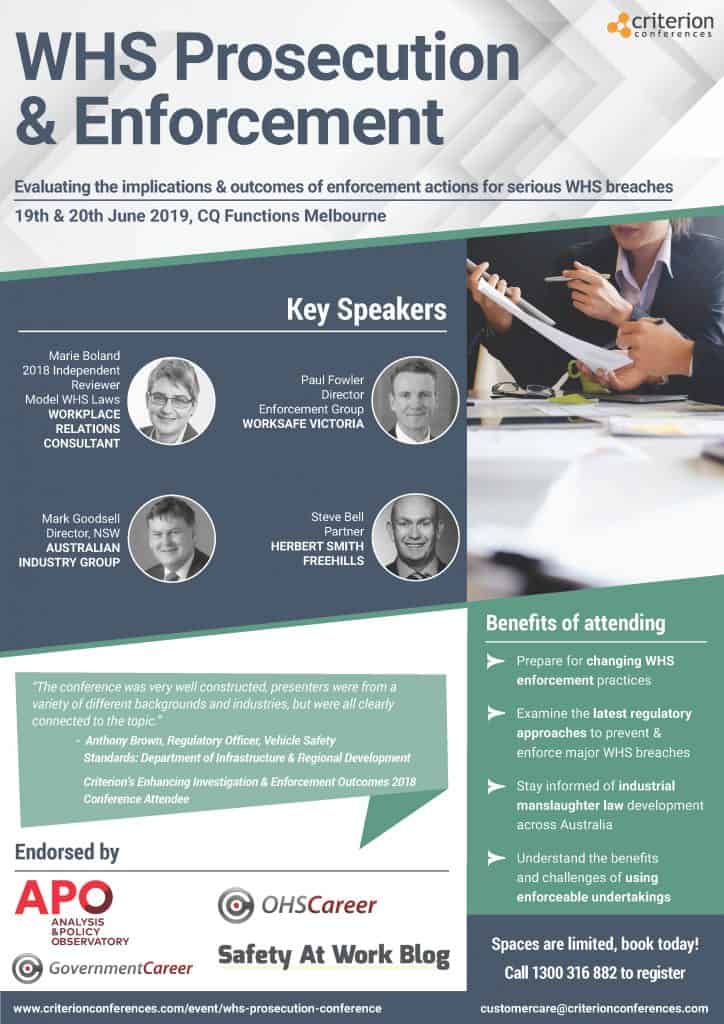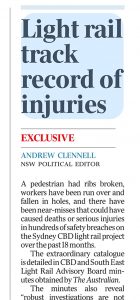
One of the hottest occupational health and safety (OHS) issues at the moment is Industrial Manslaughter but this is just one aspect of the enforcement of OHS and prosecution for breaches. In June 2019 a two-day conference on OHS/WHS Prosecution and Enforcement is being held in Melbourne, Australia with a list of respected speakers who are prominent in Australian labour law circles.
The conference is more expensive than some other OHS conferences but the list of speakers is impressive and the theme could not be more topical. (A brochure is available for download) Until March 15 2019, Criterion Conferences is applying an Early Bird discount of $500 for each delegate. SafetyAtWorkBlog has negotiated a further discount applicable to Subscribers only.


 The trade union movement was instrumental in showing that workplace bullying was a pervasive problem in Australian workplaces. Many Codes of Practice and guidances for workplace bullying and occupational violence were written shortly after the action by the Australian Council of Trade Unions almost two decades ago. But, for some reason, although sexual harassment was mentioned in those early documents, it never received the attention in occupational health and safety (OHS) circles that, in hindsight, it should have.
The trade union movement was instrumental in showing that workplace bullying was a pervasive problem in Australian workplaces. Many Codes of Practice and guidances for workplace bullying and occupational violence were written shortly after the action by the Australian Council of Trade Unions almost two decades ago. But, for some reason, although sexual harassment was mentioned in those early documents, it never received the attention in occupational health and safety (OHS) circles that, in hindsight, it should have. It is difficult to make a book about occupational health and safety (OHS) law interesting. Some try with creative design but the most successful is when laws are interpreted into real world circumstances. Thankfully
It is difficult to make a book about occupational health and safety (OHS) law interesting. Some try with creative design but the most successful is when laws are interpreted into real world circumstances. Thankfully  Occupational health and safety (OHS) is easy. Change is hard. OHS can identify workplace hazards and risks but it is the employer or business owner or Person Conducting Business or Undertaking (PCBU) who needs to make the decision to change. All of this activity occurs within, and due to, the culture of each workplace and work location. OHS lives within, and affects, each company’s organisational culture but a safety subculture is almost invisible, so it is worth looking at the broader organisational culture and there is no better show, at the moment in Australia, than
Occupational health and safety (OHS) is easy. Change is hard. OHS can identify workplace hazards and risks but it is the employer or business owner or Person Conducting Business or Undertaking (PCBU) who needs to make the decision to change. All of this activity occurs within, and due to, the culture of each workplace and work location. OHS lives within, and affects, each company’s organisational culture but a safety subculture is almost invisible, so it is worth looking at the broader organisational culture and there is no better show, at the moment in Australia, than  The
The 